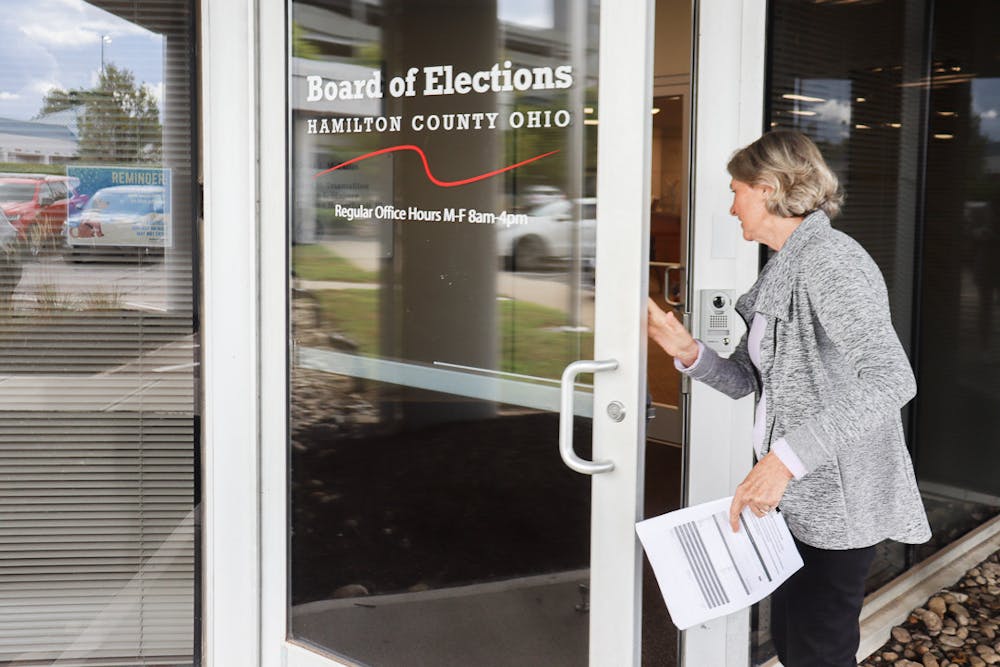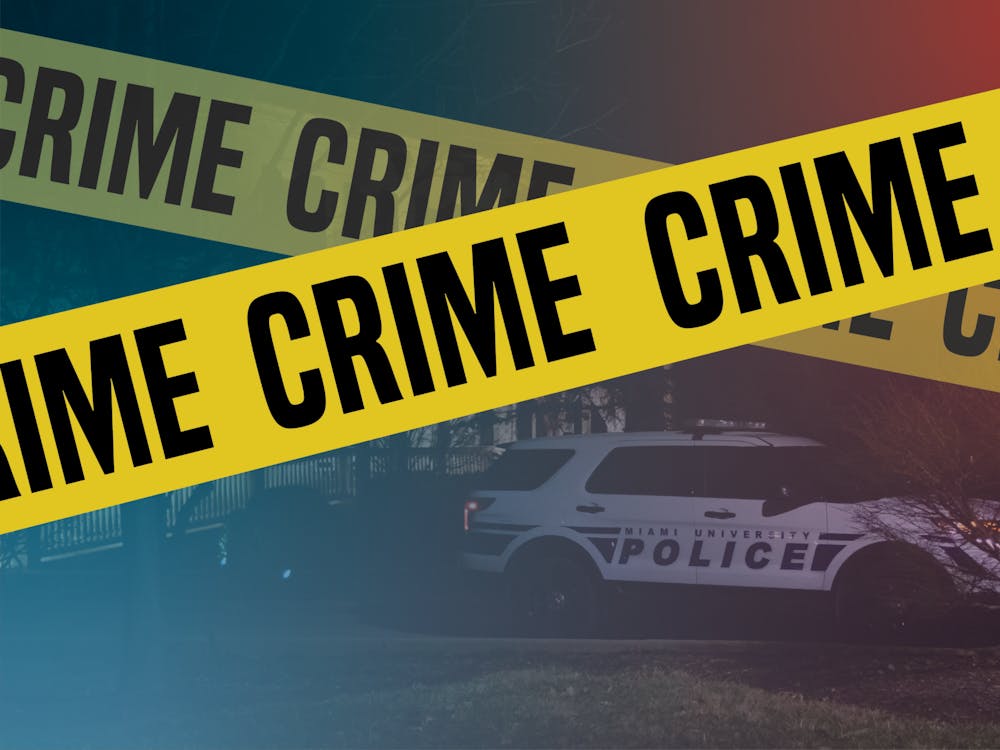On Jan. 23, Nancy Strzelecki sat in the second row of a Hamilton Board of Elections meeting.
The meeting began like any other. Board member Gwen McFarlin called the meeting to order at 8:39 a.m., and all board and audience members who were able and willing rose for the Pledge of Allegiance, led by any and all active or retired military personnel present at the meeting.
Strzelecki, resident of Cleves and recent retiree from a career as a clinical consultant at Hillrom (now Baxter), listened as board members discussed an incident of potential voter intimidation at Mt. Airy Gardens Rehabilitation and Nursing Center during the Nov. 7, 2023 election. The incident involved a nursing home worker providing political material to residents while they were voting.
“That was the first meeting I went to, and it was just like, ‘Wow, this stuff does happen,’” Strzelecki said. “And so I got involved right from that.”
And she did it by submitting hundreds of voter challenges.
Strzelecki began her involvement by meeting with Sherry Poland, director of elections for the Hamilton County Board of Elections, on Feb. 14. They discussed ways she as a citizen could help prevent voter fraud in the upcoming elections.
Strzelecki also initiated conversations with members of The Ohio Election Integrity Network, a group of conservative leaders, organizations, public officials and citizens focused on ensuring legal voting.
“We knew that they had lists of people that had moved out of state using the National Change of Address Registry (NCOA), and they had lists of people who had died but were still on the voter rolls, people that had questionable addresses, such as a UPS, Staples or a post office box somewhere,” Strzelecki said.
By the end of February, Strzelecki said she and her self-assembled team including other retired women identified nearly 600 questionable voters who fell into these categories. She presented 50 locations in which she believed to be UPS or postal stores, 77 deceased voters and over 300 voters with a change of address, including those who had moved out of state.
Strzelecki used sites like Find a Grave and obituaries to confirm data she got from the Vital Statistics Online Data Portal from the Ohio Department of Health Records for voters she believed to be deceased. She matched these names to Ohio voter rolls with their date of birth, date of death and address.
For voters she identified as having moved out of state using NCOA data, Strzelecki searched the public voter rolls in Ohio and cross-referenced names, birth years and NCOA addresses to the North Carolina’s Board of Elections public voter rolls to establish a voting history in North Carolina. For Michigan and Florida, she used their government databases to confirm voter registration and a third-party platform to determine voting activity in these states.
According to Ohio Revised Code 3503.02, “If a person goes into another state and while there exercises the right of a citizen by voting, the person shall be considered to have lost the person’s residence in this state.”
Enjoy what you're reading?
Signup for our newsletter
Strzelecki presented her findings, including hundreds of names in the form of screenshots, to Poland and Alex Linser, deputy director of the Hamilton County Board of Elections, at the end of February. These screenshots included lists of names she no longer believed to live in Hamilton County and photos of websites demonstrating that some registered addresses were UPS or postal service locations.
“We weren’t saying ‘You need to take these people off your voter rolls’” Strzelecki said. “We were just saying, ‘These are people that you need to investigate to see whether or not they really deserve to still be on our voter rolls,’ because there’s lots of things that can happen when you have people that shouldn’t be on the voter rolls.”
Poland and Linser then began investigating each name provided to them by Strzelecki. While some names Strzelecki submitted were removed due to death or other reasons, many of the names had already been removed from the voter roll.
“There is a process for removing people who have died, and the process does work,” Linser said. “Every once in a while, someone falls through the cracks, but for the most part the [process] works.”
Ahead of the election, Linser and Poland said they were already investigating addresses flagged for possibly being a UPS or postal store. The board sent out members to investigate each location, something Strzelecki and her team also did independently.
“The registration forms ask for an address to be registered at as your permanent residence, [in other words], where you lay your head at night,” said Nicole Unzicker, director of the Butler County Board of Elections.
Butler County faced similar challenges filed to them by one citizen. Though the Butler County Board of Elections had not received a single voter challenge since 2015, when it received one for a single voter, this year’s election saw hundreds, with one challenge including over 800 voters, resulting in 10 board meetings to process them.
“I will say overall, most of the challenges or corrections of precinct requests have either been denied by the board or determined to be an insufficient challenge,” said Eric Corbin, deputy director of the Butler County Board of Elections.
Throughout the summer, Strzelecki spoke a few times with Poland and Linser to discuss their findings, while continuing to submit names of voters to them.
“We took [the] list [of questionable voters] and we looked into it, and we found that in some cases, [Strzelecki’s] data was out of date,” Linser said. “We had kind of shown [Strzelecki and her team], ‘This is what we can prove, and this is what we can’t prove,’ and they ultimately decided to file [about] 300 challenges all at once.”
Using Form No. 257, Strzelecki submitted 376 voter challenges to the Hamilton County Board of Elections 10 days prior to the Sept. 4 board meeting, targeting voters she believed needed to be investigated prior to the Nov. 5 election.

These voters received a notice in the mail that their right to vote was being challenged, which included the set date of the hearing. This led to Linser and Poland scrambling to print and send hundreds of letters in the mail to these voters the day the challenges were submitted, in order to give them proper notice before the special session.
Out of the 376 voters challenged, John Girardot, a resident of Kenwood, was the only one present in the Sept. 4 board meeting to defend his right to vote.
“I moved back to the state of Ohio late June [from North Carolina], and within July got my new license over in Montgomery’s BMV and presented four pieces of physical evidence there to prove that I live in Ohio,” Girardot said at the meeting.
Some challenges were dismissed due to technical issues, including mismatched signatures on the form. For the rest, Linser and the Hamilton County board took an alternative route to immediately wiping them from the voter rolls or completely denying the challenge.
“If we’re going to take someone’s right to vote away, we need more evidence,” Linser said.
The board decided that following the hearing, the voters who did not attend would have a formal challenge submitted to their name, requiring them to verify their address at the polls. Voters submitting their ballot by mail would need to submit an additional form to verify their address.
The voter will need to either provide a photo ID with an updated address on it, or some other document that proves that they live where the voter roll has them registered at. If they complete this step, they will receive a normal ballot and be able to vote on election day. If not, they will receive a provisional ballot, which will go through the provisional voting process.
Meanwhile, Strzelecki continued to compile names of questionable voters, including those who moved to Tennessee. To Strzelecki, her work to challenge Hamilton County’s voter rolls is to protect the honesty and integrity of elections; however, to the nonpartisan group All Voting is Local, these challenges create an uphill battle for voters heading to the polls.
“Baseless voter challenges pose unnecessary barriers to the ballot,” said Greer Aeschbury, senior campaign manager at All Voting Is Local. “They are meant to dissuade and intimidate people from participating in the democratic process. These meritless challenges must stop immediately, and those who seek to prevent voters from exercising their fundamental right to vote must be held accountable.”
Both sides of the debate come from questions of integrity from the November 2020 presidential election, and whether or not barriers to the polls need to be put up or broken down.
Strzelecki intends to submit challenges until the deadline of Oct. 7, one month before the election, raising awareness that voters who move need to pay close attention to both registering their new address and canceling their old registration before voting.
And she’s not alone in her work. According to Strzelecki, she is just one of many citizen volunteers who are working in Hamilton County to keep the voter rolls clean by working with the board of elections and submitting challenges.
“All sides from the political spectrum should care that our voter rolls are accurate,” Strzelecki said.




